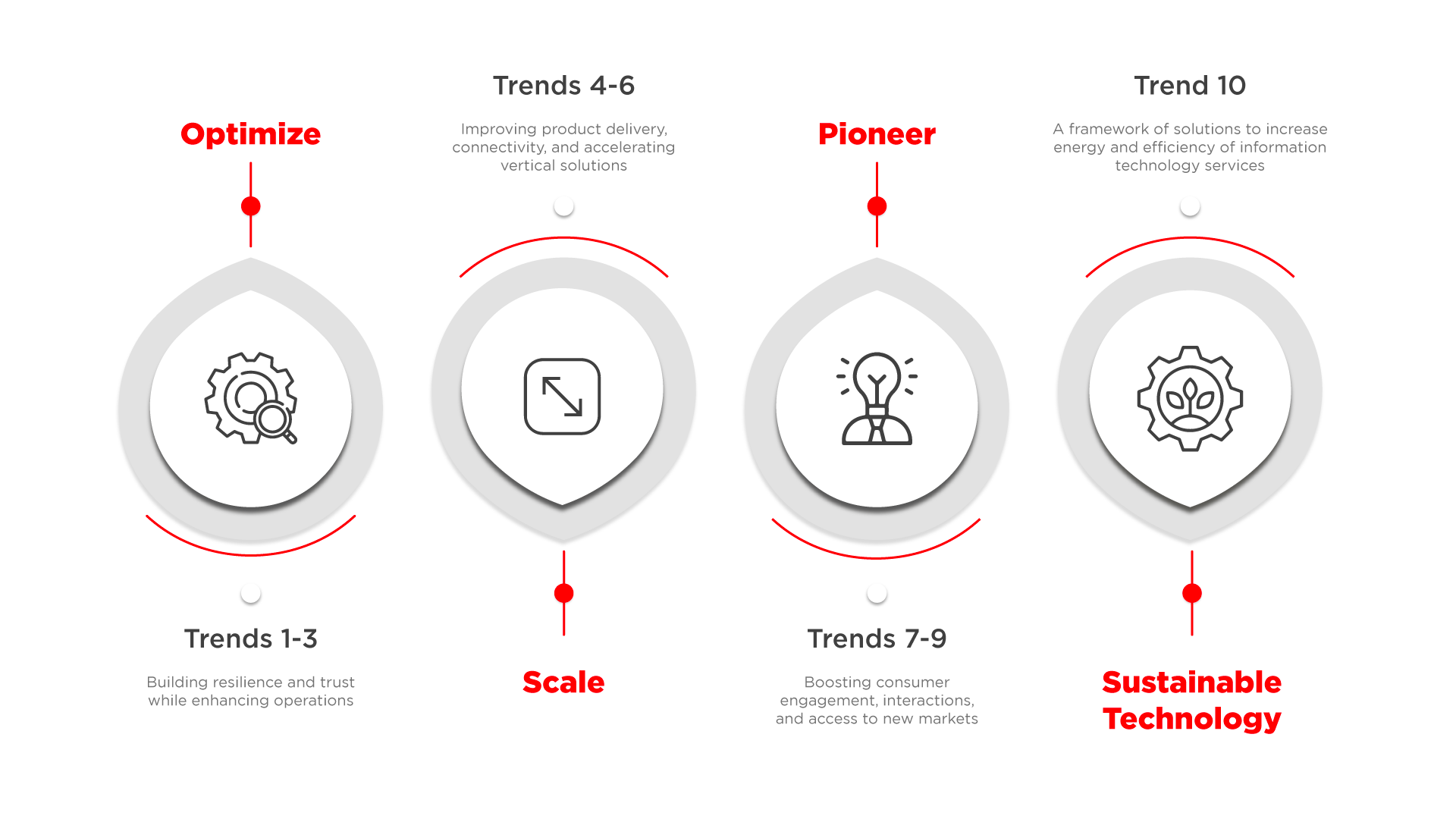Every year, Gartner selects top strategic technology trends for the coming year, based on the prediction that these trends will make a significant impact. Each one brings both opportunities and risks to an enterprise’s strategic direction, and can therefore support the development of applicable roadmaps to achieve business continuity and long-term goals.
In its latest report, Top Strategic Technology Trends 2023, Gartner takes into account the challenging and uncertain economic situation, as well as supply chain issues, energy sourcing, and skills shortages. As a result, the 2023 Gartner trends 1-10 address four main priorities:

These are Gartner’s top 10 strategic tech trends for 2023:
1. Digital Immune System (DIS)
A DIS merges technology and best practices that increase the resilience of systems, services, and products. For example, chaos engineering, supply chain security, artificial intelligence-augmented testing, auto-remediation, and site reliability engineering. This approach provides greater protection against risks, creating a more robust infrastructure that enhances the user experience (UX).
“By 2025, organizations that invest in building digital immunity will increase customer satisfaction by decreasing downtime by 80%.”
– Gartner
2. Applied Observability
This trend focuses on a systematic and integrated approach to glean insights and recommendations from observable data from across different business functions. Leveraging artificial intelligence (AI) data analytics, enterprises can make quicker and more proactive decisions, reducing the time from action to reaction.
“By 2026, 70% of organizations that successfully applied observability will achieve shorter latency for decision-making, enabling competitive advantage for target business or IT processes.”
– Gartner
3. AI Trust, Risk, and Security Management (AI TRiSM)
AI TRiSM focuses on actively managing AI models to elevate trust, governance, and reliability, reduce risk, and enhance privacy and security. This trend is aimed at improving AI adoption and acceptance.
“By 2026, organizations that operationalize AI transparency, trust, and security will see their AI models achieve a 50% improvement in terms of adoption, business goals and user acceptance.”
– Gartner
4. Industry Cloud Platforms
Cloud services, conventionally bought and implemented separately, are combined as a ‘pre-integrated’ industry cloud, relevant to a specific industry. While retaining composability, an industry cloud platform can accelerate innovation, drive organizational agility, and hasten business goals.
“By 2027, more than 50% of enterprises will use industry cloud platforms to accelerate their business initiatives.”
– Gartner
5. Platform Engineering
To accelerate digital delivery and increase end-user productivity, platform engineering consists of providing consolidated tools and workflows for a frictionless self-service experience. Both developers and end-users gain easy access to pre-approved resources.
“By 2026, 80% of software engineering organizations will establish platform teams as internal providers of reusable services, components, and tools for application delivery.”
– Gartner
6. Wireless-Value Realization
Encouraging greater use of wireless technologies, capabilities, and protocols can help to generate direct business value. Changing the mindset that wireless is simply communications technology, broader wireless ecosystems will support increased analytical capabilities, reliability and scalability, while costs can be optimized.
“By 2025, 50% of enterprise wireless endpoints will use networking services that deliver additional capabilities beyond communication, up from <15%.”
– Gartner
7. Superapps
A ‘superapp’ combines application, platform, and ecosystem, into a single app development from which third parties are able to further develop and publish bespoke “mini-apps”. A superapp is the pinnacle of a personalized and relevant digital user interface (UI) and user experience (UX).
“By 2027, more than 50% of the global population will be daily active users of multiple superapps.”
– Gartner
8. Adaptive AI
Adopting an artificial intelligence model that, once deployed, can continue to adapt and change with changing circumstances, needs, or goals, ensures businesses have access to new incoming data and can personalize output algorithms well into the future.
“By 2026, enterprises that have adopted AI engineering practices to build and manage adaptive AI systems will outperform their peers in the operationalizing AI models by at least 25%.”
– Gartner
9. Metaverse
Metaverse can be thought of as a virtual world that digitally represents people, places, and objects, for example, virtual and augmented reality. Successful adoption of the metaverse provides new opportunities for increasing engagement, social presence, employee collaboration, and enhanced UX.
“By 2027, over 40% of large organizations worldwide will be using a combination of Web3, spatial computing and digital twins in metaverse-based projects aimed at increasing revenue.”
– Gartner
10. Sustainable Technology
An overarching sustainable information technology framework consists of environmental, social, and governance technologies that support business sustainability, increase energy efficiency, and strengthen brand credibility.
“By 2025, 50% of CIOs will have performance metrics tied to the sustainability of the IT organization.”
– Gartner